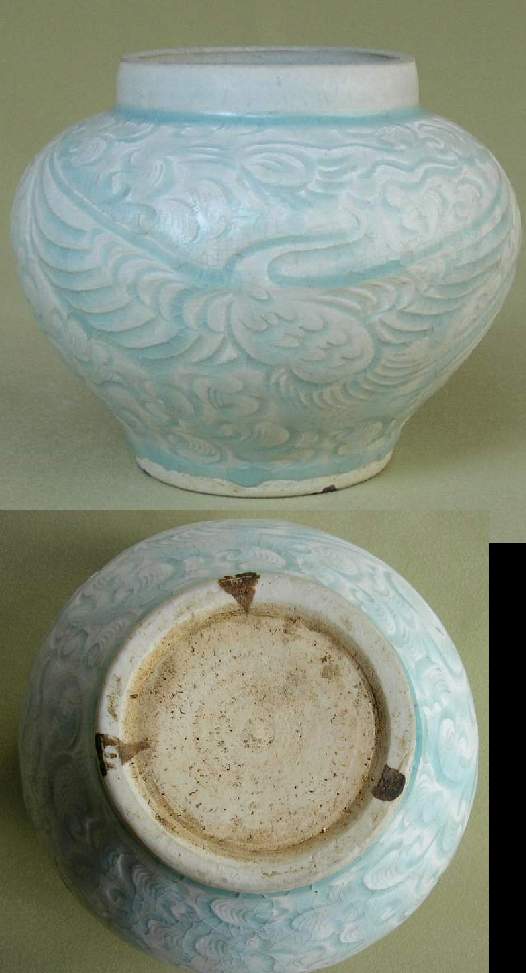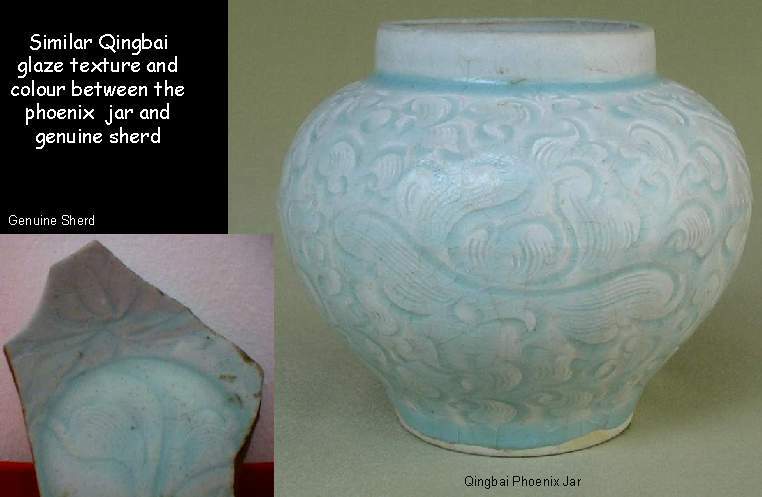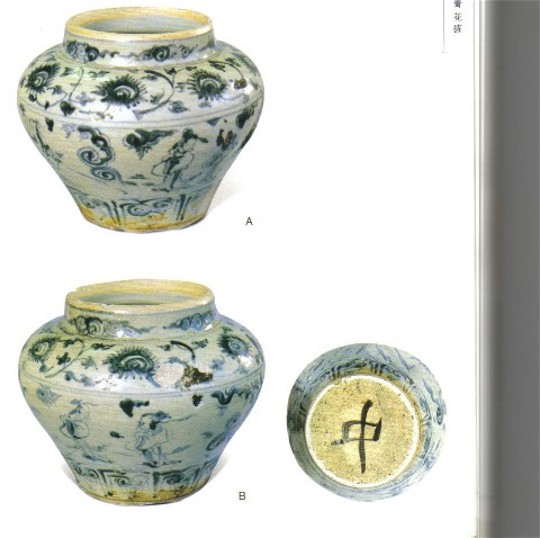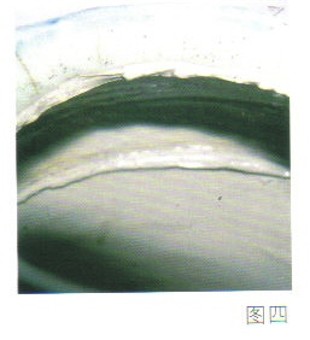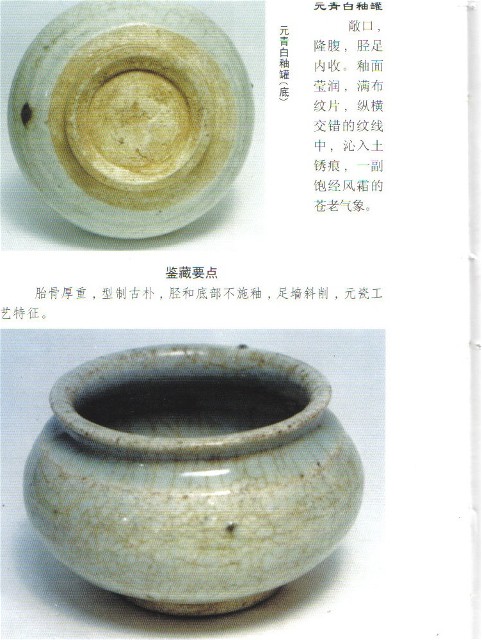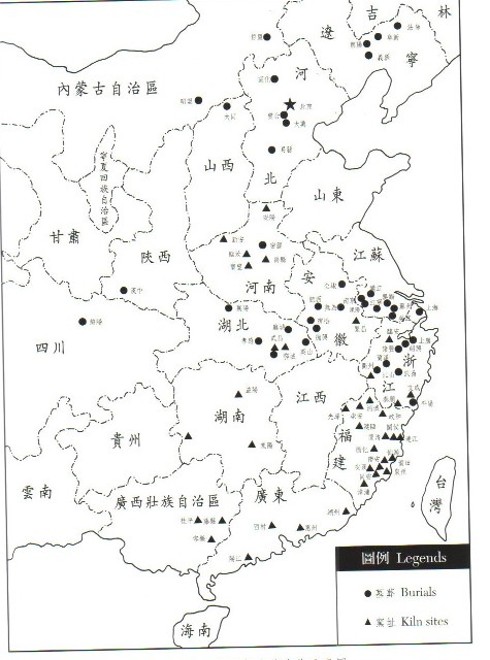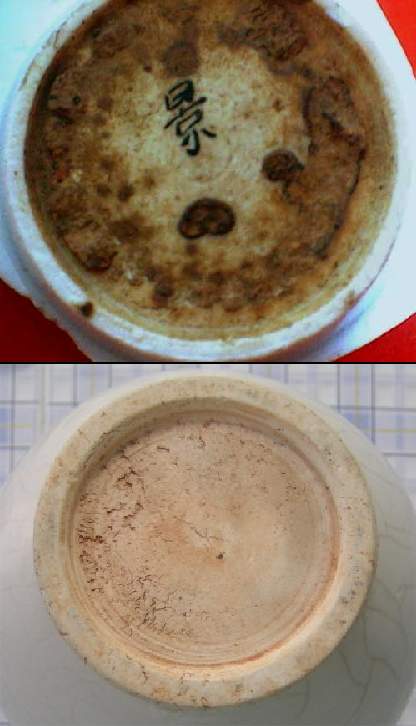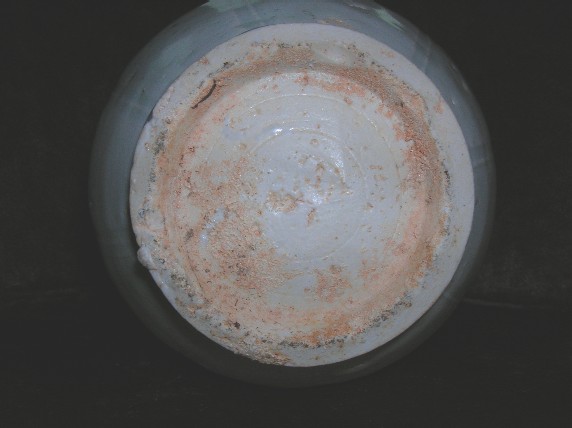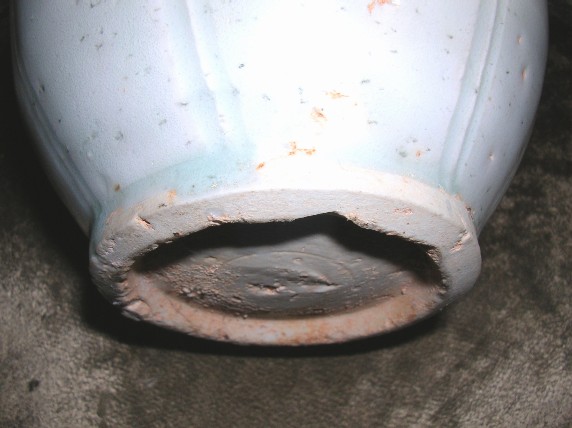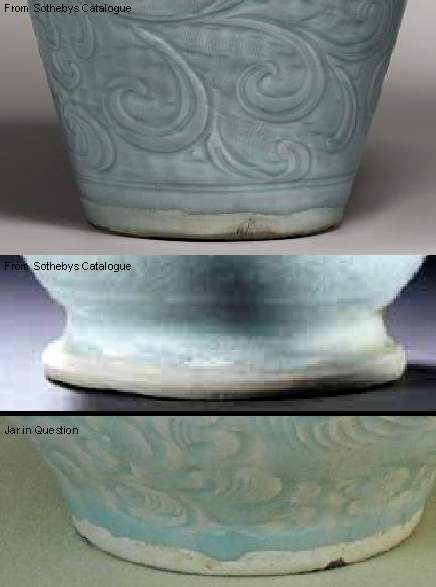
|
Subject:Re: Small Qingbai Carved Phoenix Jar
Posted By: phil Sun, Oct 01, 2006
Dear Soehandi, Ed, Ambrose & others,
firstly with regards to Soehandi`s question regarding luting, if this piece is a repro it would be a high quality one, as mentioned before if that is the case my opinion would be it has been created to deceive & whilst there are many different styles of foot rims luting appears fairly straight forward, the only possible difference being in the position of the seam. I don`t think this would cause any difficulty to the maker.
True that qingbai type wares have been found at many different sites, according to my references 44 counties in 9 different provinces both north & south of the Yangtze river but I want to stress that the finest quality pieces, (I think this jar should fall into that category if genuine) as well as the largest number were produced at the 140+ kilns located in the Jingdezhen area.
Especially the important kilns such as Hutian are justifiably famous due to the high quality porcelain, stark white in colour & we must remember that qingbai refers not only to the glaze but to the porcelain body too & as far as I know it seems that the Jingdezhen area is perfectly suited for the creation of qingbai due the availability of the raw materials necessary, (china stone & china clay) as well as water supply & abundant wood for the kilns.
I have read that one reason for the possible concentration of kilns in Jiangxi making fine white porcelains such as qingbai was the discovery of a china stone, (Nangang stone) close to Jingdezhen, apparently due to the large alumina content of this stone kaolin, (china clay) was not necessary.
Anyhow I`m afraid I`m not too well versed in the technicalities of porcelain production & would prefer to leave this aspect to others but it is a fact that the best & most amount of qingbai wares were produced in Jingdezhen.
Soehandi, I`m afraid that until I get a new camera I`m unable to post pics of the references previously mentioned but I would reccomend the book, (again I think I mentioned this in a previous post.) "Qingbai ware, porcelain of the Sung & Yuan dynasties" ISBN: 0 7286 0339 X, published by the Percival David foundation & with commentaries by Rosemary Scott, Amy Barnes & others.
Ambrose, as I have the pics on my hard drive I`m in a position to post more of the qingbai jar that you requested. It`s a granary jar of not uncommon type, height is just under 8" or 20cm. I think this is a fairly good & typical example of a type of ware produced in large numbers. The colour is not as fine as that shown on Soehandi`s jar being of a slight greyish blue cast but the foot appears a dead match to that posted by Ed as an example, (according to Hazel, my wife, the description in chinese of the features of this foot & the slight "pot bellied" base is very good, if it`s not too much bother I`d like to ask Ed for the source of the pic.) The paste of this jar exhibits the sugary texture we expect & is a bit loose as can be seen in these pics. Although very bright white as expected the unglazed portion has turned to the buff colour that again we like to see.
Kind regards,
Phil.
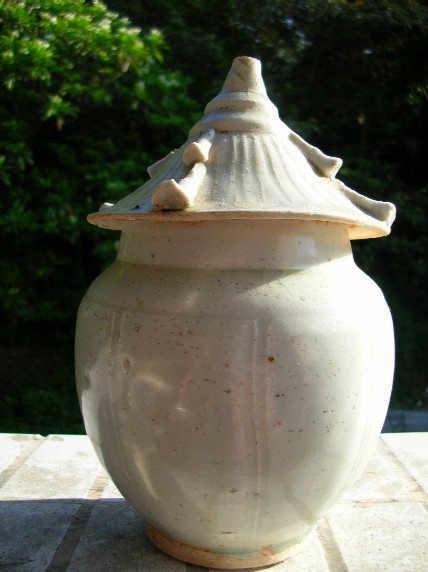
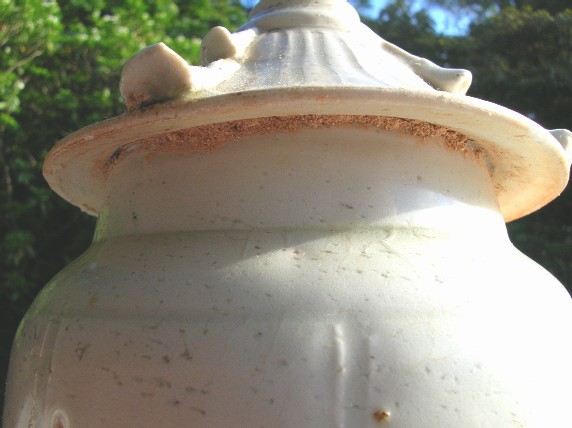
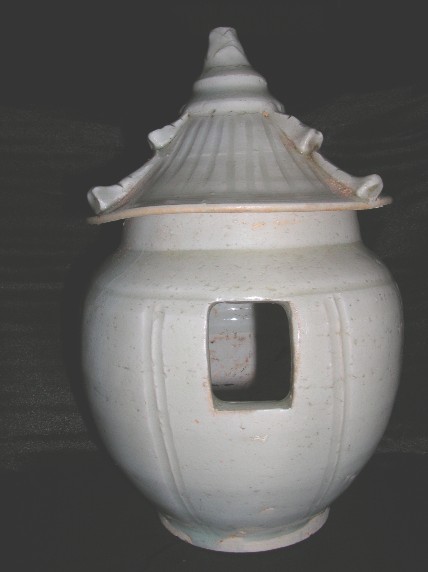


|
 Small Qingbai Carved Phoenix Jar
Small Qingbai Carved Phoenix Jar  ( China & Japan ) - Soehandi - Sep 24, 2006 (07:27 AM)
( China & Japan ) - Soehandi - Sep 24, 2006 (07:27 AM)  Re: Small Qingbai Carved Phoenix Jar - phil - Sep 25, 2006 (05:56 AM)
Re: Small Qingbai Carved Phoenix Jar - phil - Sep 25, 2006 (05:56 AM)  Re: Small Qingbai Carved Phoenix Jar - Edward Shumaker - Sep 25, 2006 (08:18 PM)
Re: Small Qingbai Carved Phoenix Jar - Edward Shumaker - Sep 25, 2006 (08:18 PM)  Re: Small Qingbai Carved Phoenix Jar - ambrose - Sep 26, 2006 (08:14 AM)
Re: Small Qingbai Carved Phoenix Jar - ambrose - Sep 26, 2006 (08:14 AM)  Re: Small Qingbai Carved Phoenix Jar - Soehandi - Sep 26, 2006 (08:41 AM)
Re: Small Qingbai Carved Phoenix Jar - Soehandi - Sep 26, 2006 (08:41 AM)  Re: Small Qingbai Carved Phoenix Jar - phil - Sep 26, 2006 (11:56 AM)
Re: Small Qingbai Carved Phoenix Jar - phil - Sep 26, 2006 (11:56 AM)  Re: Small Qingbai Carved Phoenix Jar
Re: Small Qingbai Carved Phoenix Jar  - Edward Shumaker - Sep 26, 2006 (12:59 PM)
- Edward Shumaker - Sep 26, 2006 (12:59 PM)  Re: Small Qingbai Carved Phoenix Jar - phil - Sep 26, 2006 (03:26 PM)
Re: Small Qingbai Carved Phoenix Jar - phil - Sep 26, 2006 (03:26 PM)  Re: Small Qingbai Carved Phoenix Jar - Edward Shumaker - Sep 26, 2006 (04:42 PM)
Re: Small Qingbai Carved Phoenix Jar - Edward Shumaker - Sep 26, 2006 (04:42 PM)  Re: Small Qingbai Carved Phoenix Jar - phil - Sep 26, 2006 (05:28 PM)
Re: Small Qingbai Carved Phoenix Jar - phil - Sep 26, 2006 (05:28 PM)  Re: Small Qingbai Carved Phoenix Jar - Edward Shumaker - Sep 26, 2006 (06:37 PM)
Re: Small Qingbai Carved Phoenix Jar - Edward Shumaker - Sep 26, 2006 (06:37 PM)  Re: Small Qingbai Carved Phoenix Jar - ambrose - Sep 27, 2006 (05:02 AM)
Re: Small Qingbai Carved Phoenix Jar - ambrose - Sep 27, 2006 (05:02 AM)  Re: Small Qingbai Carved Phoenix Jar
Re: Small Qingbai Carved Phoenix Jar  - Edward Shumaker - Sep 27, 2006 (01:04 PM)
- Edward Shumaker - Sep 27, 2006 (01:04 PM)  Re: Small Qingbai Carved Phoenix Jar
Re: Small Qingbai Carved Phoenix Jar  - Edward Shumaker - Sep 27, 2006 (05:19 PM)
- Edward Shumaker - Sep 27, 2006 (05:19 PM)  Re: Small Qingbai Carved Phoenix Jar
Re: Small Qingbai Carved Phoenix Jar  - Soehandi - Sep 27, 2006 (08:27 AM)
- Soehandi - Sep 27, 2006 (08:27 AM)  Re: Small Qingbai Carved Phoenix Jar - ambrose - Sep 27, 2006 (06:28 PM)
Re: Small Qingbai Carved Phoenix Jar - ambrose - Sep 27, 2006 (06:28 PM)  Re: Small Qingbai Carved Phoenix Jar
Re: Small Qingbai Carved Phoenix Jar  - phil - Sep 27, 2006 (10:45 PM)
- phil - Sep 27, 2006 (10:45 PM)  Re: Small Qingbai Carved Phoenix Jar - Edward Shumaker - Sep 28, 2006 (05:19 AM)
Re: Small Qingbai Carved Phoenix Jar - Edward Shumaker - Sep 28, 2006 (05:19 AM)  Re: Small Qingbai Carved Phoenix Jar - phil - Sep 28, 2006 (11:40 AM)
Re: Small Qingbai Carved Phoenix Jar - phil - Sep 28, 2006 (11:40 AM)  Re: Small Qingbai Carved Phoenix Jar - ambrose - Sep 28, 2006 (05:58 PM)
Re: Small Qingbai Carved Phoenix Jar - ambrose - Sep 28, 2006 (05:58 PM)  Re: Small Qingbai Carved Phoenix Jar - Soehandi - Sep 29, 2006 (08:41 AM)
Re: Small Qingbai Carved Phoenix Jar - Soehandi - Sep 29, 2006 (08:41 AM)  Re: Small Qingbai Carved Phoenix Jar - Edward Shumaker - Sep 30, 2006 (05:18 PM)
Re: Small Qingbai Carved Phoenix Jar - Edward Shumaker - Sep 30, 2006 (05:18 PM)  Re: Small Qingbai Carved Phoenix Jar
Re: Small Qingbai Carved Phoenix Jar  - phil - Oct 01, 2006 (01:37 AM)
- phil - Oct 01, 2006 (01:37 AM)  Re: Small Qingbai Carved Phoenix Jar
Re: Small Qingbai Carved Phoenix Jar  - ambrose - Oct 01, 2006 (08:29 AM)
- ambrose - Oct 01, 2006 (08:29 AM)  Re: Small Qingbai Carved Phoenix Jar - inga - Oct 01, 2006 (02:28 PM)
Re: Small Qingbai Carved Phoenix Jar - inga - Oct 01, 2006 (02:28 PM)  Re: Small Qingbai Carved Phoenix Jar
Re: Small Qingbai Carved Phoenix Jar  - Soehandi - Oct 08, 2006 (07:46 AM)
- Soehandi - Oct 08, 2006 (07:46 AM)  Re: Small Qingbai Carved Phoenix Jar - phil - Oct 13, 2006 (10:57 PM)
Re: Small Qingbai Carved Phoenix Jar - phil - Oct 13, 2006 (10:57 PM)  Re: Small Qingbai Carved Phoenix Jar - Nev - Feb 05, 2015 (12:02 AM)
Re: Small Qingbai Carved Phoenix Jar - Nev - Feb 05, 2015 (12:02 AM)  Re: Small Qingbai Carved Phoenix Jar - phil - Sep 25, 2006 (12:17 PM)
Re: Small Qingbai Carved Phoenix Jar - phil - Sep 25, 2006 (12:17 PM) 